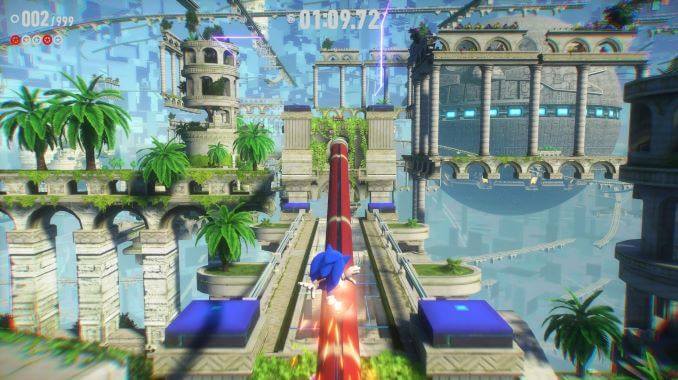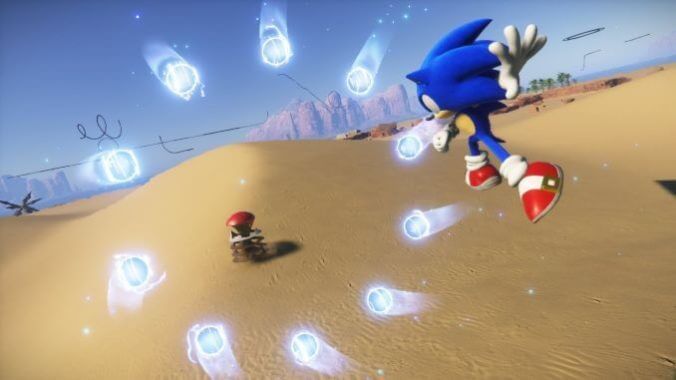Sonic Frontiers is the most frustrating kind of game. Not because it’s bad; actually, I’m surprised (and relieved) to say it’s a largely solid game when everything’s working. But it’s also confoundingly inconsistent and slapdash. Poorly optimized, bloated open worlds and confusing menus and tutorials clash with good platforming, great music and clever level and encounter design to deliver one of the weirdest games I’ve ever played. Sonic fans should rest easy, though, as it seems like Frontiers is shaping up to be what many of them have wanted for years. That said, I’m not a Sonic fan.
At first glance, an open-world game sounds like a concerning step for the Sonic franchise. In a series whose buggy, glitch-ridden 3D legacy could (generously) be defined as shaky at best, creating more margin for error doesn’t seem like the best way to find a new direction for the series. Beyond Sonic’s history, open-world games, especially ones that reimagine classic franchises, are a tossup. Chasing 2017’s The Legend of Zelda: Breath of the Wild’s lasting financial and critical success is undoubtedly an appealing business venture, but most of these games end up feeling like formulaic, hollow regurgitations of Breath of the Wild’s best innovations and ideas.
Looking a bit deeper, though, it’s clear that the Sonic franchise needs more freedom to realize its core ethos. It always has. From its inception, Sonic’s always been about going fast, but the series’ branching levels made speed a reward for mastery and discovery, rather than just haphazardly rushing from zone to zone. It’s something that a surprising number of Sonic games have misunderstood over the years, opting to put players in more rigid segments of gameplay that feel like quick-time events with paths appearing at stops in the mashing and rail-grinding. By busting these platforming environments wide open, Frontiers injects much-needed new life into the series. Sadly, that newfound flame doesn’t burn quite as bright by Frontiers’ end as it did in the beginning hours.
Frontiers’ open, freeing structure lets you explore at your own speed in your own way. In doing so, you’re sure to fall into Frontiers’ trap. Maybe you’ll happen upon an interesting-looking marker or boss, or perhaps you’ll spot one of the challenges used to unlock parts of a map on the horizon. You might even find one of the game’s fishing spots! Initially, each individual distraction has a way of pulling you from one puzzle or mini platforming challenge to the next. It feels so natural and enticing that I completed 90% of Frontiers’ first level completely naturally. Sure, it’s a trick employed by nearly every open-world game to date, but Frontiers actually genuinely benefits from being an open world game. That’s thanks in no small part to the varying types of challenges and distractions Frontiers throws at you.
Imagine if a child took a massive toy box full of pieces of different Sonic levels—stuff like rails, springs, and platforms—and scattered them across the horizon of a massive landscape. Now imagine each piece actually fit together to make mini platforming challenges that don’t just intersect remarkably well, but also reward players with collectibles, new vantage points, shortcuts or boss fights.
Those smaller platforming sections make up a big portion of the game’s appeal. They even make Sonic’s trademark speed work much better than it has in a long time; in most Sonic games, error is met with a game over, or sending you back to a checkpoint. In Frontiers, messing up might require you to restart the challenge, but more often than not, you’ll be greeted with something new on the ground and an opportunity to take the challenge on again.

Unfortunately, Frontiers is so poorly equipped to actually render the elements that make up these floating bits that you might not even notice them until you’ve blazed past them on your way to the next chaos emerald. Even when playing the game on my Xbox Series X, most of these structures faced severe pop-in. Most of the time, the pop-in was distracting but never took away from my experience playing the game. That said, multiple points in the story require you to find these utilitarian floating islands. That means that unless you’re very close to the actual ramp or spring that’s supposed to get you where you need to go, you’re probably going to end up stuck wandering the map looking for a bridge or switch or rail of some kind. On multiple occasions, I was stuck on such sections for an unbearably long time. After talking to other people who’ve had time with Frontiers, it sounds like I wasn’t alone, either.
Something that stuck in my mind while playing this game was that it was initially teased to come out last year for the franchise’s 30th anniversary. I can’t even begin to fathom what this game would look like were Team Sonic forced to put this game out a year ago. That’s not to say it’s severely broken, it just feels like the team didn’t get nearly enough time to round out the game’s many edges. Nearly every boss fight or challenge in the game hinges on smart, genuinely fun design, but falls short on the idea’s actual execution. Timers for certain challenges feel arbitrary and untested, the camera is uncooperative in boss fights, and sometimes entire tutorials just don’t tell us what we need to know.
The game’s structure falls victim to the same haphazardness; instead of fast travel to landmarks, or even unlockable map points or challenges, you can only unlock fast travel to two separate NPCs that can help you level up some of Sonic’s different abilities, but only if you get lucky in the fishing minigame. The only other element resembling fast travel in the entirety of Sonic Frontiers is that unlocking new sections of a map will also reveal new segments of long grind rails that span big chunks of each world. It’s fun to fly through the world at dizzying speeds on your way to the next objective, but I would’ve much preferred to save the literal hours I spent running around looking for things with some good old fashioned fast travel.
Fast travel’s absence didn’t just feel like a poor decision, it felt like padding. The same kind of padding you’re sure to find in any number of open-world games du jour; the kind of games that ask you to defeat spongey enemies to collect dozens of meaningless collectibles in order to earn another opportunity to go out and collect even more resources. This repetition causes Frontiers to lose its luster as you progress. Repetition is the name of the game here as four of the five worlds follow the same exact structure. I don’t just mean that each one requires the same type of gameplay, either; I mean that story beats, challenges, mission objectives all follow the same structure. Before a cutscene started, I knew what I was going to see, what I was going to have to do and where I’d be sent next.
In its formulaic nature, Frontiers shoots itself in the foot by robbing itself of any opportunity for discovery or freshness, which are the same things that make open world games function on a structural level. By the halfway point, even stumbling on new enemies feels rote. In fact, my drive to explore and move forward in the story waned more and more in each of the four subsequent worlds until I opted to grind for collectibles in the fishing minigame instead of picking them up in the overworld by the end of the game.
It doesn’t help that the typically bombastic, goofy energy that defined a lot of Sonic’s other adventures is nowhere to be found. Instead of comically hokey dialogue, cutscenes are just boring. From the writing to the directing to even the dull performances from its beloved, usually energetic voice cast, Frontiers feels flat. I’d much rather laugh at something dumb than groan at something that’s meant to be played as an emotional beat that ends up falling on its face.
Sonic Frontiers is a far cry from many of Sonic’s previous disasters, but it’s not devoid of its low points. Frustrating structure and annoying technical issues severely detract from the experience, but even at its lowest, Frontiers isn’t abysmal, just confusing and boring. Bloated world design doesn’t take away from the thrilling high of zooming through a landscape at mach speeds, nailing a good time on a platforming challenge or catching a comically large fish in Big’s fishing minigame. There’s just not much else to hang onto here. Sorry, Sonic fans: your malaise continues.
Sonic Frontiers was developed by Sonic Team and published by Sega. Our review is based on the Xbox Series X version. It’s also available for PlayStation 5, the Switch, Xbox One, PlayStation 4, and PC.
Charlie Wacholz is a freelance writer and college student. When he’s not playing the latest and greatest indie games, competing in Smash tournaments or working on a new cocktail recipe, you can find him on Twitter at @chas_mke.

